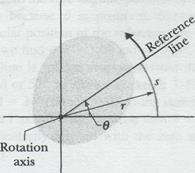Angular Position
 Figure 11-2
Figure 11-2
|
Figure 11-2 shows a reference line, fixed in the body, perpendicular to the rotation axis, and rotating with the body. The angular positionof this line is the angle of the line relative to a fixed direction, which we take as the zero angularposition. In Fig. 11-3, the angular position  is measured relative to the positive direction of the
is measured relative to the positive direction of the  axis. From geometry, we know that
axis. From geometry, we know that  is
is

Here  is the length of arc (or the arc distance) along a circle and between the
is the length of arc (or the arc distance) along a circle and between the  axis (the zero angular position) and the reference line;
axis (the zero angular position) and the reference line;  is the radius of that circle.
is the radius of that circle.
An angle defined in this way is measured in radians(rad) rather than in revolutions (rev) or degrees. The radian, being the ratio of two lengths, is a pure number and thus has no dimension. Because the circumference of a circle of radius  is
is  , there are
, there are  radians in a complete circle:
radians in a complete circle:

 Fig. 11-3
Fig. 11-3
|
and thus 
We do not reset  to zero with each complete rotation of the reference line about the rotation axis. If the reference line completes two revolutions from the zero angular position, then the angular position
to zero with each complete rotation of the reference line about the rotation axis. If the reference line completes two revolutions from the zero angular position, then the angular position  of the line is
of the line is
 rad.
rad.
 For pure translational motion along the
For pure translational motion along the  direction, we can know all there is to know about a moving body if we are given
direction, we can know all there is to know about a moving body if we are given  , its position as a function of time. Similarly, for pure rotation, we can know all there is to know about a rotating body if we are given
, its position as a function of time. Similarly, for pure rotation, we can know all there is to know about a rotating body if we are given  , the angular position of the body's reference line as a function of time.
, the angular position of the body's reference line as a function of time.
Дата добавления: 2015-06-17; просмотров: 699;
